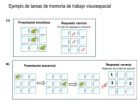(Press-News.org) A study conducted at the University of Granada and the University of York in Toronto, Canada, has revealed that bilingual children develop a better working memory –which holds, processes and updates information over short periods of time– than monolingual children. The working memory plays a major role in the execution of a wide range of activities, such as mental calculation (since we have to remember numbers and operate with them) or reading comprehension (given that it requires associating the successive concepts in a text).
The objective of this study –which was published in the last issue of the Journal of Experimental Child Psychology– was examining how multilingualism influences the development of the "working memory" and investigating the association between the working memory and the cognitive superiority of bilingual people found in previous studies.
Executive Functions
The working memory includes the structures and processes associated with the storage and processing of information over short periods of time. It is one of the components of the so-called "executive functions": a set of mechanisms involved in the planning and self-regulation of human behavior. Although the working memory is developed in the first years of life, it can be trained and improved with experience.
According to the principal investigator of this study, Julia Morales Castillo, of the Department of Experimental Psychology of the University of Granada, this study contributes to better understand cognitive development in bilingual and monolingual children. "Other studies have demonstrated that bilingual children are better at planning and cognitive control (i.e. tasks involving ignoring irrelevant information or requiring a dominant response). But, to date, there was no evidence on the influence of bilingualism on the working memory.
The study sample included bilingual children between 5 and 7 years of age (a critical period in the development of the working memory). The researchers found that bilingual children performed better than monolingual children in working memory tasks. Indeed, the more complex the tasks the better their performance. "The results of this study suggest that bilingualism does not only improve the working memory in an isolated way, but they affect the global development of executive functions, especially when they have to interact with each other", Morales Castillo states.
Music Education
According to the researcher, the results of this study "contribute to the growing number of studies on the role of experience in cognitive development". Other studies have demonstrated that children performing activities such as music education have better cognitive capacities. "However, we cannot determine to what extent children perform these activities due to other factors such as talent or personal interest".
"However, the children in our study were bilingual because of family reasons rather than because of an interest in languages.
INFORMATION:
Bilingual children have a better 'working memory' than monolingual children
2013-02-20
ELSE PRESS RELEASES FROM THIS DATE:
Healthy rivalry could boost sport and business performance
2013-02-20
New research shows that people can recover from poor performance when rivals comment on their failures. The research, to be published in the Journal of Experimental Social Psychology, shows that while criticism from team members sends individuals into downward performance spirals, external criticism can be a trigger that boosts performance as people try to prove the outsiders wrong. The research carried out by the University of Exeter, Amherst College and the University of Stirling offers a method of improving performance following setbacks and can be applied both in the ...
New taxonomy of platinum nanoclusters
2013-02-20
Physicists have gained new insights into the inner intricacies of the structural variations of metallic nanoclusters. This work by Luca Pavan, Cono Di Paola and Francesca Baletto from King's College London, UK, is about to be published in EPJ D. It takes us one step closer to tailoring on-demand characteristics of metallic nanoparticles. Indeed, the geometric structure of these nanoclusters influences their chemical and physical properties, which differ from those of individual molecules and of bulk metals.
The problem resides in the difficulty in evaluating the optimal ...
Molecular basis identified for tissue specific immune regulation in the eye and kidney
2013-02-20
Both AMD, which affects around 50 million people worldwide, and aHUS, a rare kidney disease that affects children, are associated with incorrectly controlled immune systems. A protein called complement factor H (CFH) is responsible for regulating part of our immune system called the complement cascade. Genetic alterations in CFH have been shown to increase a person's risk of developing either AMD or aHUS, but rarely both. Why this is the case has never been explained until now.
Researchers from the Wellcome Trust Centre for Cell Matrix Research and the Ophthalmology and ...
The nano-channel that disentangles knots
2013-02-20
The DNA, just like hair, has a tendency to become knotted, thus it may be useful to disentangle it.
Unfortunately, it is not possible to "actively" choose at random (or better, in one solution) the filaments with the desired features, and this is why scientists adopt "passive" solutions like, for instance, having the DNA pass through nano-pores or nano-channels.
"Channels and filaments have physical features we may exploit to selectively let a type of molecule pass through" explains Micheletti. "You can have more or less entangled filaments and featuring knots of different ...
New technology in the magnetic cooling of chips
2013-02-20
Luis Hueso, the CICnanoGUNE researcher, together with researchers from the University of Cambridge, among others, has developed a new technology in the magnetic cooling of chips based on the straining of materials. Compared with the current technologies, this advance enables the impact on the environment to be lessened. The work has been published recently in the prestigious journal Nature Materials.
Current cooling systems, be they refrigerators, freezers or air conditioning units, make use of the compression and expansion of a gas. When the gas is compressed, it changes ...
A self-healing protective coating for concrete
2013-02-20
Scientists are reporting development of what they describe as the first self-healing protective coating for cracks in concrete, the world's most widely used building material. Their study on the material — which is inexpensive and environmentally friendly — appears in the journal ACS Applied Materials & Interfaces.
Chan-Moon Chung and colleagues explain that protecting concrete roads, bridges and other structures from developing tiny cracks has been a major technological challenge. Cracks allow water, salt used for deicing and air to enter the concrete. During winter ...
New IOM report highlights PEPFAR's successes
2013-02-20
WASHINGTON -- The President's Emergency Plan for AIDS Relief (PEPFAR) has saved and improved millions of lives worldwide and offered proof that HIV/AIDS services can be effectively delivered on a large scale even in countries with high rates of disease and resource constraints, says a new congressionally mandated evaluation conducted by the Institute of Medicine.
Moving forward, PEPFAR needs to intensify efforts to help its partner countries develop the capacity to manage their own programs, sustain the gains that have been made in controlling the HIV epidemic, and improve ...
New imaging device that is flexible, flat, and transparent
2013-02-20
WASHINGTON, Feb. 20, 2013— Digital cameras, medical scanners, and other imaging technologies have advanced considerably during the past decade. Continuing this pace of innovation, an Austrian research team has developed an entirely new way of capturing images based on a flat, flexible, transparent, and potentially disposable polymer sheet. The team describes their new device and its possible applications in a paper published today in the Optical Society's (OSA) open-access journal Optics Express.
The new imager, which resembles a flexible plastic film, uses fluorescent ...
Can insurers save money by providing free diabetes-related medications and supplies?
2013-02-20
New Rochelle, NY, February 20, 2013–Reducing financial barriers to medication access—a strategy known as value-based insurance design (VBID)—can improve medication adherence and management of chronic diseases such as diabetes. The economic and patient-perceived benefits of eliminating co-payments for diabetes-related medications and supplies are described in a trend-setting study published in Population Health Management, a peer-reviewed journal from Mary Ann Liebert, Inc., publishers. The article is available free on the Population Health Management website at http://www.liebertpub.com/pop.
In ...
Ancient 'Egyptian blue' pigment points to new telecommunications, security ink technology
2013-02-20
A bright blue pigment used 5,000 years ago is giving modern scientists clues toward the development of new nanomaterials with potential uses in state-of-the-art medical imaging devices, remote controls for televisions, security inks and other technology. That's the conclusion of an article on the pigment, Egyptian blue, in the Journal of the American Chemical Society.
Tina T. Salguero and colleagues point out that Egyptian blue, regarded as humanity's first artificial pigment, was used in paintings on tombs, statues and other objects throughout the ancient Mediterranean ...




